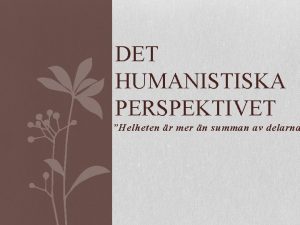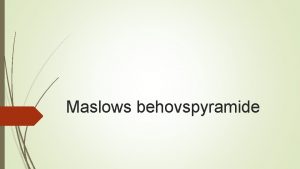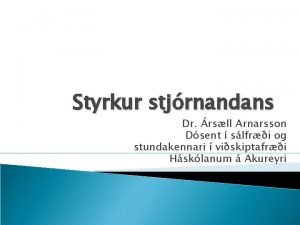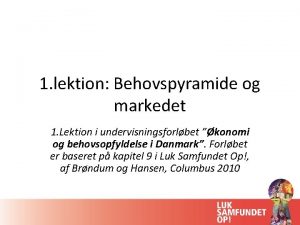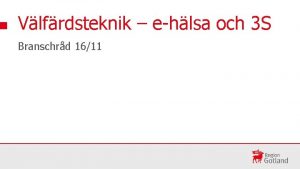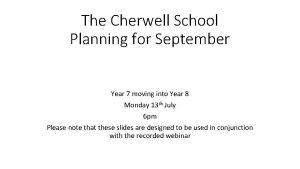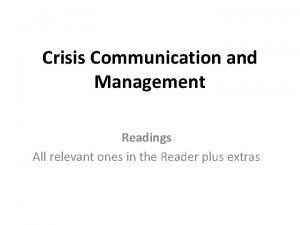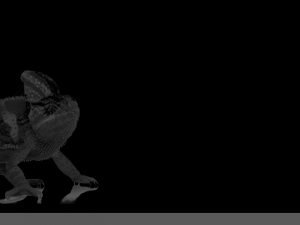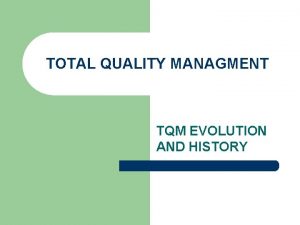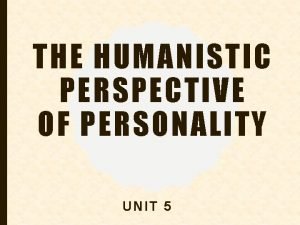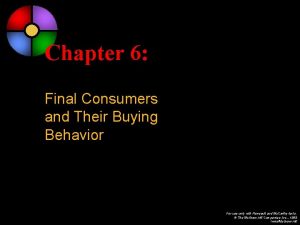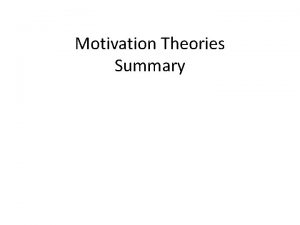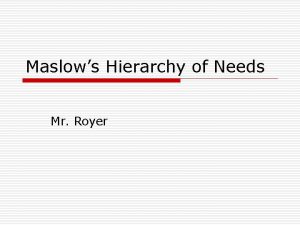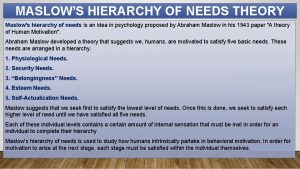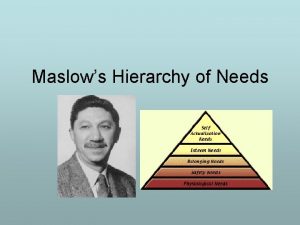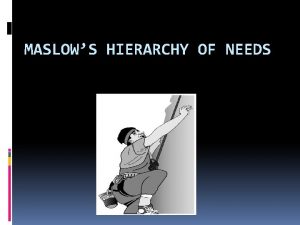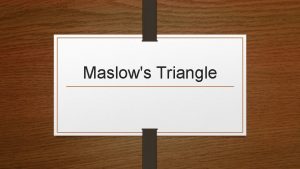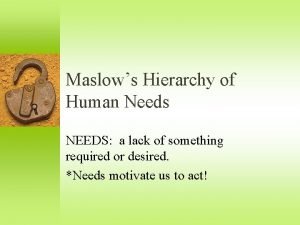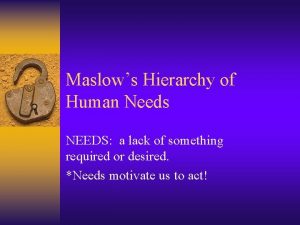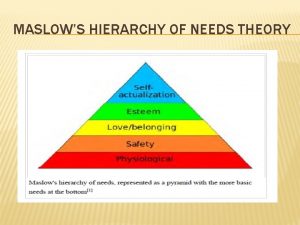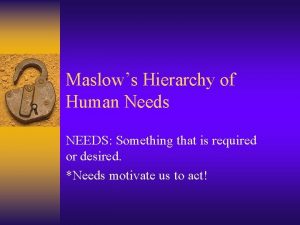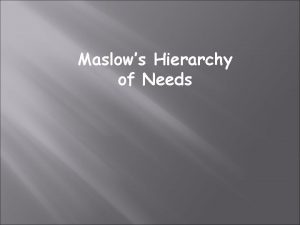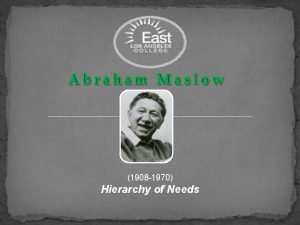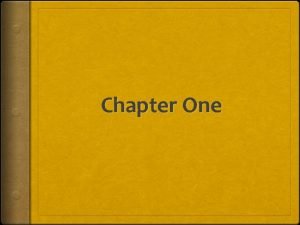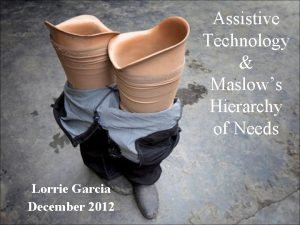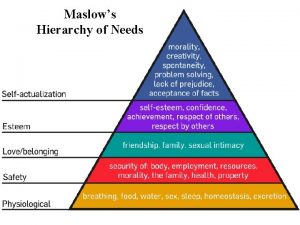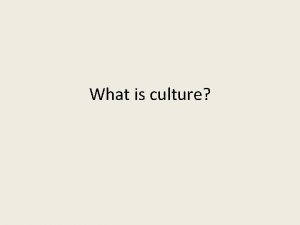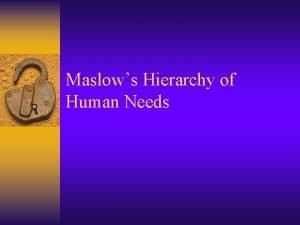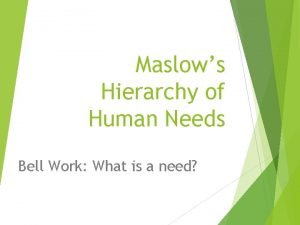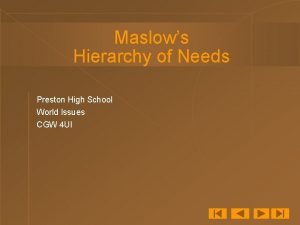Managment Maslows Hierarchy of Needs Maslows Hierarchy of
































- Slides: 32

Managment

Maslow’s Hierarchy of Needs

Maslow’s Hierarchy of Needs

Physiological Needs

Esteem Needs

Love and Belonging

Safety Needs

Self-Actualization

Lets clarify Maslow’s Theory

Douglas Mc. Gregor

Theory X Management Assumes

Theory Y Management Assumes

The Hard Approach and Soft Approach • .

Applying Maslow's Hierarchy of Needs to Business Management

Applying Maslow's Hierarchy of Needs to Business Management

The Problem with Theory X according to Douglas Mc. Gregor

Theory XY Management Application

Democratic style

Laissez-faire

Steps to Solving a Case Study (write this down)

Case 1: To Medicate or Not to Medicate • Terry Kelly received a National Institute of Mental Health grant for research in the Western Tropics. As part of her personal gear, she took along a considerable amount of medication, which her physician had prescribed for use, should Kelly find herself in an active malaria region. Later, after settling into a village, Kelly became aware that many of the local people were quite ill with malaria. • Kelly's Dilemma: since she had such a large supply of medication, much more than she needed for her personal use, should she distribute the surplus to her hosts?

Solution

Case 2: Witness to Murder • • Mary Thompson had been conducting fieldwork in a Southeast Asian community for 18 months. Her house was ideally located on the edge of the village plaza, allowing her to readily observe daily activities that took place in the plaza. In addition to gatherings of women who shared food preparation tasks and talk, and groups of men working individually on carvings, the plaza was regularly a gathering place for men at night. One night while Thompson was working up some statistical problems in her house, she was distracted by loud, seemingly argumentative discussions in the plaza. When the noise of the argument reached a high pitch, she decided to investigate the situation. Just as she stepped from her doorway, she saw one of the men in the group of five, angrily raise his machete and deliver a deadly blow to another--Tom--in the group. Stunned silence fell over the other three men, as they watched their companion quickly bleed to death before their eyes. Moment’s later people from the other homes began moving into the plaza in response to the wailing that came from the man who had wielded the machete. Mournful crying and wailing was carried throughout the village. The family members of the dead man carried him to their home and began funeral preparations. The next evening, Tom was buried. The man who had dealt the deadly blow was allowed to participate in the funeral and to make a death payment to the family of the deceased.

Case 2: Witness to Murder • Two days after the funeral, three regional policemen came to the village. As part of a new governmental program designed to reduce blood feuds, the regional authorities now regularly sought to arrest and jail people who were involved in killings. They had heard about the recent death. • They began questioning the villagers in an attempt to determine if Tom had been "murdered. " Thompson had written a detailed description of the events of the night of Tom's death in her notebook which contained a running record of village activities. • Thompson's Dilemma: (1) since she knew the police would question her, should she quickly tear out and destroy the pages in her notebook where the events were recorded? (2) When questioned by the police should she, like the other villagers, plead ignorance concerning the killing?

Solution

Case 3: Hiding a Suspect • • George Teller had been conducting research on an American Indian reservation for two years. During that time he developed strong, close relationships with many of the people who lived on the reservation. One morning while sitting at the breakfast table with the family he was staying with, the conversation became centered on an event that had occurred one week before. This is what was recounted. Six men and five women were gathered in one of the men's homes having a party. As the night wore on and the effects of wine and beer drinking began to be felt by the people at the party, one of the men--Ted--went into a bedroom. He returned wearing a holster which contained an ivory-handled pistol. He began showing everyone his "quick draw" and, while doing so, one of the other men--Mike--began teasing him. Ted responded to this teasing by putting the pistol against Mike's forehead. The stories that went around the next day expressed confusion over how the gun happened to go off and whether or not Mike was shot right then, or whether or not Ted had the gun when Mike was shot. Anyway, after the shooting everyone left Mike's home accept his girlfriend, who called the police. After taking Mike's body to the mortuary, the police arrested Ted was released the next morning after a hearing where the tribal judge charged him with involuntary manslaughter and placed him on two years' probation. Now, at breakfast, people talked of a rumor going about the

Case 3: Hiding a Suspect • reservation that the ex-husband of Mike's girlfriend--Joe--had arrived at the party angry and "feeling high. " Joe got into an argument with Mike and his ex-wife and wound up shooting Mike with Ted's gun. The tribal police were questioning everyone about this possibility, particularly since Joe seemed to be the center of a lot of recent violent activities on the reservation. • Teller asked his hosts if they thought Joe had killed Mike: the answer was yes and that nobody had seen Joe for several days-"he's hiding out, as usual, now that the FBI is looking for him. " • Later that same day, Joe showed up at the house and asked Teller to take him to a distant town so he could catch a bus "for California. " Joe said he was going back to his job for a while to earn money, and that he would be coming back to the reservation in a couple of months. • Teller's Dilemma: Should he or should he not take Joe to the bus station? In either case, if questioned by the Tribal Police, should he tell them he had seen Joe?

Solution

Case 4: "Hot" Gifts • Rose Stone moved into an urban ghetto in order to study strategies for survival used by low-income residents. During the first six months of research, Stone was gradually integrated into the community through invitations (which she accepted) to attend dances, parties, church functions, and family outings, and by "hanging out" at local service facilities (Laundromats, health centers, recreation centers, and so on). She was able to discern that there were two important survival tactics used by the community residents which she could not engage in: the first was a system of reciprocity in the exchange of goods and services (neither of which she felt she had to offer), and the second was outright theft of easily pawned or sold goods (clothing, jewelry, radios, TVs, and so on). • One night, a friend from the community stopped by "for a cup of coffee" and conversation. After they had been talking for about two hours, Stone's friend told her that she had some things she wanted to give her. The friend went out to her car and returned with a box of clothing (Stone's size) and a record player.

Case 4: "Hot" Gifts • Stone was a bit overwhelmed by the generosity of the gift and protested her right to accept such costly items. Her friend laughed and said, "Don't you worry, it's not out of my pocket, " but then she became more serious and said, "Either you are one of us or you aren't one of us. You can't have it both ways. " • Stone's Dilemma: Suspecting that the items she was being offered was probably "hot" (e. g. , stolen), she was afraid that if she wore the clothes in public, or had the record player in her apartment, she would be arrested for "accepting stolen goods. " At the same time, she knew that "hot" items were often given to close friends when it was observed that they could use them. Still, this implied that there would be reciprocal giving (not necessarily in kind) at a later date. So, should she accept or refuse the proffered gifts?

Solution

Undercover Boss
 Villkorslös kärlek psykologi
Villkorslös kärlek psykologi Maslows behovspyramide eksempler
Maslows behovspyramide eksempler þarfapýramídi maslows
þarfapýramídi maslows Købemotiver
Købemotiver Behovspyramiden
Behovspyramiden Projekplan
Projekplan Virginia henderson grundlæggende behov
Virginia henderson grundlæggende behov Maslows theory maintains that
Maslows theory maintains that Cherwell school reviews
Cherwell school reviews Rental managment software
Rental managment software Process managment
Process managment Total quality management system
Total quality management system Life cycle of a record
Life cycle of a record What is resource managment
What is resource managment Drilling managment software
Drilling managment software Texas assessment management
Texas assessment management The importance of resource management
The importance of resource management Network managment
Network managment Relevant ones
Relevant ones User managment
User managment Lap id kosten
Lap id kosten Pragwater
Pragwater Web content managment
Web content managment Tqm inventor
Tqm inventor Primary needs and secondary needs
Primary needs and secondary needs Procedure of need analysis in esp
Procedure of need analysis in esp Primary needs and secondary needs
Primary needs and secondary needs Henry murray theory
Henry murray theory Strategic gender needs and practical gender needs
Strategic gender needs and practical gender needs Humanistic perspective on personality
Humanistic perspective on personality Routinized response behavior is what a consumer does when
Routinized response behavior is what a consumer does when Design hierarchy of needs
Design hierarchy of needs Abraham maslow hierarchy of needs summary
Abraham maslow hierarchy of needs summary
